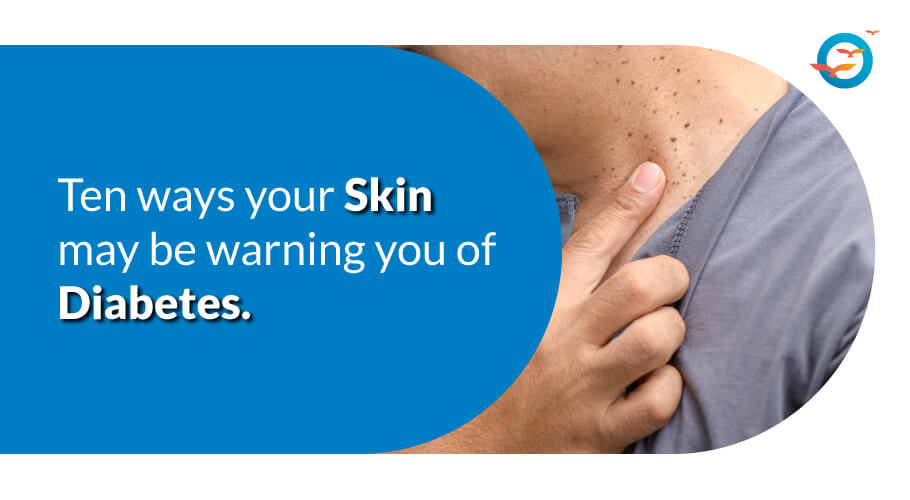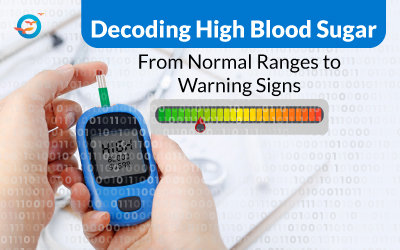10 Ways Your Skin May Be Warning You of Diabetes

How type 2 diabetes affects your skin?
One of the scarier aspects of diabetes is the lack of symptoms in the early stages. More than half of all diabetics usually do not even know they have the disorder until it shows up in a “routine" check-up or the condition worsens to a stage where symptoms show up.
However, the effect of high blood sugar can be distinguished in certain skin conditions, one of which is sudden changes in the skin.
Here are ten telltale signs from your skin that you need to get your blood sugar tested.
Diabetes skin warning signs of diabetics
1. Acanthosis Negricans
This is a common sign of pre-diabetes. It shows up as dark patches of smooth skin—described as having a velvety texture—on the back of the neck, groin, or in the armpit area. If you notice such patches, get your blood sugar checked asap.
On the positive side, pre-diabetes is completely reversible, so take heart. Visit a diabetes specialist and follow their guidance on diet, exercise and stress management, and medicines. For help in reversing pre-diabetes or diabetes, visit us at freedomfromdiabetes.org/programs.
2. Necrobiosis Lipoidica
This condition is characterized by small pimple-like bumps on the skin. Over time, these bumps develop into yellowish, reddish, or brownish patches of hard skin. The skin in the area is generally itchy and painful to touch. This condition may be cyclic, I.e. it may flare up suddenly, then disappear and re-appear.
Action Plan:
Visit your doctor to get your BSL checked, and if you do have diabetes, ensure you actively take steps to keep your blood sugar level (BSL) in the regular range
Also, visit a dermatologist for help in managing your skin condition.
3. Digital Sclerosis
Digital Sclerosis is the name given to another diabetes pre-cursor. It is characterized by tight, wax-textured skin on the fingers and/or toes. Over time, the fingers become stiff and might feel like hard bumps on your fingertips. This thick, swollen texture can spread to the skin of the forearms, upper arms, back, shoulders, and neck as well as the face shoulders, and chest. The thick skin looks like orange peel and if it shows up on knees, elbows or ankles, you may have difficulty bending the particular joint.
Action Plan
Show the condition to your doctor, a diagnosis of diabetes should be followed by active adherence to the doctor’s prescription and necessitates a change in diet and exercise. Being overweight is a huge risk factor for many disorders. So start by reducing your excess weight. You may also consider consulting a physiotherapist for exercises to help in bending and straightening the joints.
4. Bullosis Diabetricorum/Diabetic Bullae (Blisters)
Sometimes, diabetics suddenly develop blisters on their hands and/or feet. These look like burn blisters, but unlike blisters that result from burns, these do not cause pain. This condition is known as diabetic bullae or bullocks diabetricorum.
Action Plan
- Visit a doctor for treatment for the blisters, so as to prevent infection.
- Get yourself checked for high blood sugar, and if diagnosed with diabetes, get the requisite treatment.
5. Open Sores and Slow-healing Wounds
High blood sugar tends to damage circulation and cause nerve damage. As a result, any wound or cut doesn’t get the nutrition and oxygen needed for healing. Diabetic wounds of this nature tend to occur especially on the feet, where due to lack of sensation, the patient may not even notice it until it becomes bad. These wounds are also known as diabetic ulcers.
Action Plan
If you have diabetes, make it a regular routine to check your feet carefully for any sores, cuts, and wounds. If you notice any problem, attend to it immediately.
If it develops into an open wound, ensure you get it cleaned and dressed regularly. Simultaneously, work with a qualified diabetic doctor to rein in your BSL.
6. Diabetic Dermopathy (Shin Spots)
Shin spots are quite common in diabetics. They appear as brownish spots or lines, usually on the shins (hence the name), and sometimes on the arms, upper legs, and other parts of the body, too.
The spots/lines sometimes create a depression in the skin but are mostly symptomless. They are often confused with age spots, but unlike age spots, these shin spots mostly—but not always—fade away in time.
Action Plan
- Talk to your doctor about the spots
- Get tested for high BSL, and, if diagnosed, get the proper treatment.
7. Eruptive Xanthomatosis
This skin problem manifests as small, reddish-yellow bumps that look like pimples. Unlike pimples, they acquire a yellowish tinge. They are usually found on the buttocks, upper legs, elbows, or back of the knees, but can appear anywhere on the body. They are tender and itchy, but they will clear up as soon as the diabetes is brought under control
Action Plan
- Tell your doctor immediately, as this problem is a sign of unmanaged diabetes.
- Get your diabetes under control with a proper diet-exercise-medicine-stress management routine.
8. Dry Skin
High and unmanaged high BSL causes poor circulation, which often results in dry, itchy skin. This can lead to other skin problems, so it is important to get it diagnosed and treated early.
Action Plan
- Getting your BSL under control is imperative to treating this problem.
- If the dry skin persists, talk to a dermatologist for help in treating the problem.
9. Xanthelasma
Excessive weight is one of the key triggers of insulin resistance—the condition that causes diabetes, and a host of other disorders categorized under the umbrella of metabolic syndrome. Excessive fat when it gets into the bloodstream and cells compromise insulin’s ability to allow glucose into the cells.
As a result, the glucose accumulates in the bloodstream. Along with glucose levels, fat levels too rise in the blood, and sometimes they show up as yellowish, scaly patches around the eyelids.
Action Plan
Bringing your BSL under control will often get rid of the patches around your eyes as well. So visit your doctor and get your blood sugar level checked. If it is high, get on a proper diet-exercise routine to get it under control. If necessary, your doctor will also prescribe medications.
10. Skin Tags
This is a common condition, wherein excess skin grows and sticks out, much like a narrow stalk. They are usually harmless and painless but can get chafed from rubbing against clothing. If this occurs or the skin tag is irritated—due to the chafing—it can be removed easily by a medical professional.
Action Plan
Skin tags usually don't require any treatment at all. However, if its appearance bothers you or it becomes irritated and painful it can be easily taken out with a simple medical procedure.
So, visit a dermatologist for a proper consult
At the same time, skin tags have been associated with high BSL, so do get your blood sugar levels checked to eliminate the possibility of diabetes.
FAQs
1. What are the skin symptoms that might indicate diabetes?
Some common skin symptoms include Acanthosis Negricans, Necrobiosis Lipoidica, Digital Sclerosis, Diabetic Bullae, Slow-healing Wounds, Dry Skin, Skin Tags etc.
2. Why does diabetes affect my skin?
Diabetes can affect blood circulation and reduce the skin’s ability to heal, leading to various skin issues.
3. Can good skin care help prevent diabetes-related skin issues?
Yes, maintaining good skin hygiene and moisturizing can help prevent some skin problems, visit a dermatologist for help in managing your skin condition.
4. Can lifestyle changes improve my skin health and reduce diabetes risk?
Absolutely! Eating a balanced diet, staying active, and managing stress can improve overall health and potentially reduce diabetes risk.

